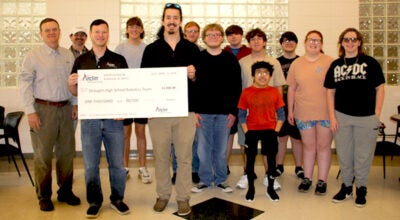Researcher using dogs in battle against pine tree disease
Published 12:00 am Tuesday, July 5, 2011
AUBURN UNIVERSITY – The mystery surrounding a disease that is killing Southern pine trees could possibly be solved by Auburn University detector dogs. Lori Eckhardt, associate research professor in Auburn’s School of Forestry and Wildlife Sciences, is using dogs from the school’s EcoDogs program to detect deadly fungus in pine tree roots.
The pathogenic fungus involved in “Southern pine decline” disease is introduced by fungus-carrying beetles that burrow below ground and attack the roots. Especially susceptible are stressed trees during times of drought, when the trees produce a chemical that attracts beetles.
Southern pine decline is spreading and now affects more than a million acres in more than 80 counties across the southeastern United States, Eckhardt said. The disease hurts industry financially and it reduces endangered species habitat.
“The current way to detect the fungus is to dig up the roots, but this method is time consuming and does not cover much area,” Eckhardt said. “Airplanes are useful in helping us spot dying trees, but this just looks above ground. We have to look below ground for these beetles.”
The School of Forestry and Wildlife Sciences is working with the Forest Health Cooperative to develop methods for managing infected pine plantations and to research ways to combat the beetles and the disease. The Forest Health Cooperative is an association supported by the university, industry and governmental agencies to fight pine decline and other insects and diseases affecting pine forests.
Root-feeding, pine decline beetles are different from Southern pine bark beetles, which attack trees above ground.
“For the Southern pine beetle, there has been 30 years of research and we know how to manage it, but research on the pine decline beetle has been underway for only 10 years,” said Eckhardt, who began studying pine decline as a doctoral student in 1999 and is considered one of the nation’s foremost authorities on the disease.
Auburn’s detector dogs, from the College of Veterinary Medicine’s Animal Health and Performance Program, are being trained to sniff out the scent of two fungi, Leptographium and Heterobasidion, that are attacking tree roots.
“In our tests the dogs detect the presence of fungus-infected roots,” she said. “We are working on small test plots and are researching the possibility of using them on pine plantations.”
The advantages are that the dogs are noninvasive and do not disturb the beetles or spread the fungus. As the dogs sniff through a pine tree stand, the handlers record the location of the “hits” – when the dog sits down – which would let landowners know the area and percentage of infected trees. By using this method, the researchers may not need to dig up the roots as compared to the current method of inspecting trees.
“Digging up the roots disturbs the trees causing them to release stress chemicals that can attract more beetles to the area,” she said. “Cutting down the trees doesn’t help because the beetles stay underground.”
The development of fungus-finding dogs is in the beginning stage, but Eckhardt and the dog trainers hope it will lead to a successful and feasible program in fighting Southern pine decline.
“This could be a very positive step,” Eckhardt said. “It’s not a cure, but we hope the dogs will help advance our management of the pine plantations and help in our research to stop the disease.”





